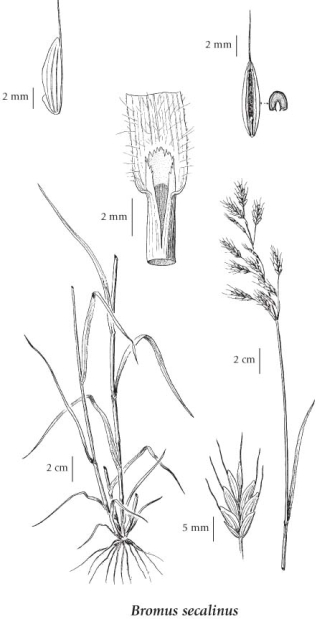Bromus secalinus L.
rye brome
Poaceae (Grass family)
Introduction to Vascular Plants
rye brome
Poaceae (Grass family)
Introduction to Vascular Plants
Species Information
General:
Annual grass from fibrous roots; stems smooth or hairy only at the nodes, 30-80 cm tall.
Leaves:
Sheaths usually smooth to finely hairy; blades (2) 3-8 mm wide, flat, usually somewhat soft-hairy (to smooth); ear-shaped lobes lacking at the leaf-bases; ligules smooth or sparsely hairy on the outer surfaces, minutely or coarsely jagged, (2) 1.5-3 mm long.
Flowers:
Inflorescence a loose, usually nodding panicle, (5) 7-20 cm long, with all the branches and flowers on 1 side of the axis; spikelets 5- to 9-flowered, strongly compressed, smooth to short-hairy, 10-20 mm long; florets ultimately spreading, exposing the curved rachilla joints; lower glumes lanceolate, 3- to 5-nerved, 4-6 mm long, the upper ones broader, cylindrical or more or less egg-shaped to lanceolate, 5- (7-) nerved, 5-8 mm long; lemmas rough, without prominent nerves, somewhat compressed, (6) 7-9 mm long, the margins usually in-rolled, rounded at the tips, bidentate, awned, the awns about 5 mm long, flattened, in age usually broadly spreading to somewhat zig-zagging, sometimes reduced to 1-2 mm long; paleas about equalling or exceeding the lemmas; anthers about 1 mm long.
Illustration

If more than one illustration is available for a species (e.g., separate illustrations were provided for two subspecies) then links to the separate images will be provided below. Note that individual subspecies or varietal illustrations are not always available.
Illustration Source: The Illustrated Flora of British Columbia